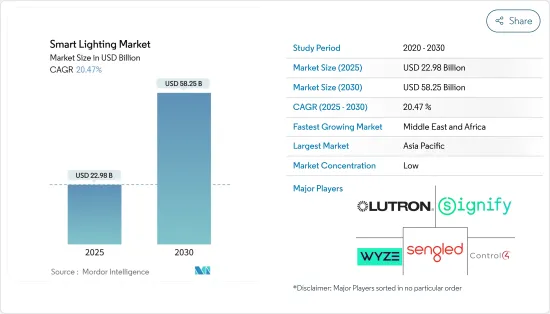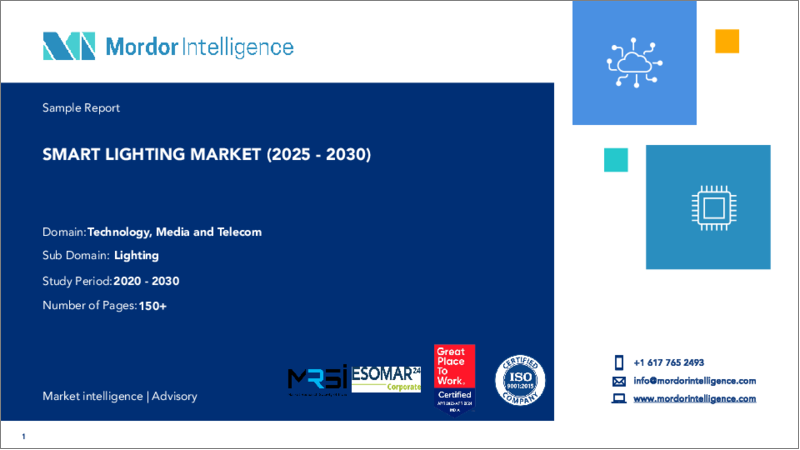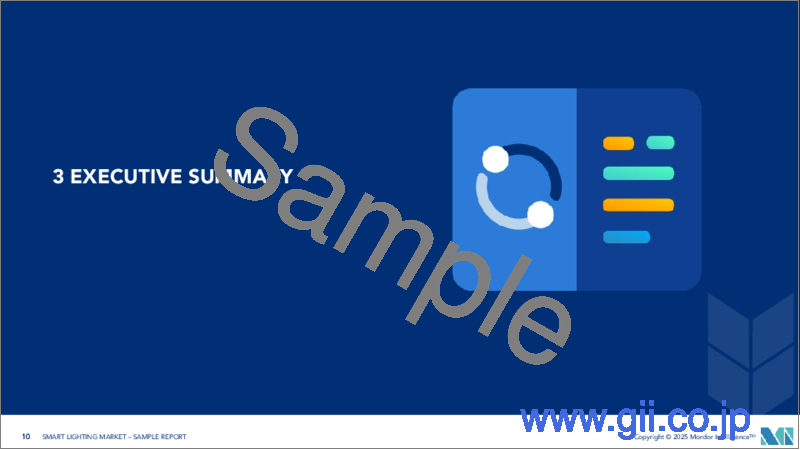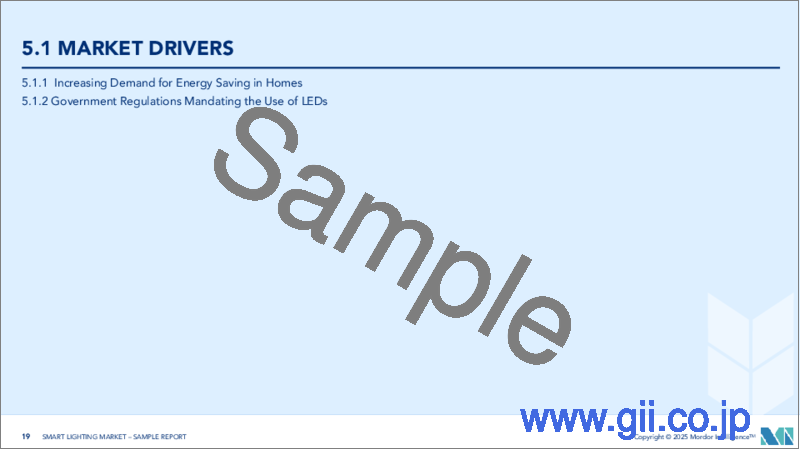|
|
市場調査レポート
商品コード
1687446
スマート照明:市場シェア分析、産業動向・統計、成長予測(2025年~2030年)Smart Lighting - Market Share Analysis, Industry Trends & Statistics, Growth Forecasts (2025 - 2030) |
||||||
カスタマイズ可能
適宜更新あり
|
|||||||
| スマート照明:市場シェア分析、産業動向・統計、成長予測(2025年~2030年) |
|
出版日: 2025年03月18日
発行: Mordor Intelligence
ページ情報: 英文 154 Pages
納期: 2~3営業日
|
- 全表示
- 概要
- 目次
スマート照明の市場規模は2025年に229億8,000万米ドルと推定され、予測期間(2025-2030年)のCAGRは20.47%で、2030年には582億5,000万米ドルに達すると予測されます。

スマート照明市場は、エネルギー効率の高い家庭用ソリューションに対する需要の高まりによって、力強い成長を遂げています。この成長を支えているのは、進化する消費者行動、技術の進歩、積極的な政府政策、発光ダイオード(LED)などの技術の採用です。電力使用を最適化するように設計されたスマート照明システムは、照明レベルやスケジュールを正確に制御できるため、市場拡大にさらに拍車をかけています。
主なハイライト
- さらに、センサーとコネクティビティの統合により、スマート照明は自然光と部屋の占有率に適応できるようになり、市場拡大を後押ししています。政府や環境機関の政策を含む世界のイニシアティブは、二酸化炭素排出量を削減し気候変動に対処するためにエネルギー効率の高い照明を提唱しており、市場をさらに活性化させています。
- パーソナライズされた家庭環境に対する消費者の関心は、家庭での省エネソリューションに対する需要の増加とともに、市場の成長を促進しています。スマート照明システムは、ユーザーが好みの雰囲気になるように明るさ、色、温度を調整できるように、幅広いカスタマイズを提供します。さらに、コネクテッドホームの人気の急上昇と、インテリアデザインやホームオートメーションへの関心の高まりが、機能性と美的魅力を融合させたスマート照明ソリューションの需要を押し上げています。
- 照明が健康や幸福に及ぼす影響に対する認識が高まるにつれ、家庭における省エネソリューションに対する需要が高まるとともに、スマート照明ソリューションの採用が急増し、市場の成長を後押ししています。
- 様々なブランド間で標準化されたプロトコルや互換性がないため、消費者に混乱が生じ、製品選択がますます難しくなっています。この課題は、将来性、アップグレードオプション、新興技術との相互運用性をめぐる不確実性によってさらに悪化し、情報に基づいた意思決定と採用の妨げとなっています。
スマート照明市場の動向
スマートランプと器具の製品タイプセグメントが大きな市場シェアを占める見込み
- 技術革新、エネルギー効率目標、スマートシティ構想への注目の高まりにより、照明業界の変革が進んでおり、スマートランプとフィクスチャがその先導役となっています。これらのソリューションは、照明システムの運用を世界的に再定義し、強化された機能性、接続性、持続可能性の利点を提供しています。
- 世界中の政府がスマートシティ構想を展開しており、街路照明の適応やリアルタイムのモニタリングなどの目的でIoT対応のランプや器具を取り入れています。注目すべき例としては、米国のスマートシティ展開やインドのスマートシティミッションなどがあり、いずれもインテリジェント照明システムの重要性を強調しています。
- 2023年10月、ドイツテレコムはエッジIoTソリューション企業のcThings.coと共同で、重要な都市インフラ向けの5Gネットワークスライシングの可能性を紹介しました。このデモンストレーションは、最近ポーランドのクラクフで開催されたhubraum 5G Testing Labの発表会で行われました。things.coと米国を拠点とするValmontの製品で、スマートシティアプリケーション向けに調整されたスマートランプポールにスポットライトが当てられました。
- スマート・ライティング・ソリューションは、モノのインターネット(IoT)に依存し、デバイス通信を可能にすることで照明を最適化します。このネットワークには、センサー、リレー、ゲートウェイ、その他のコンポーネントが含まれ、効率的な照明管理のための稼働率、時間、日照データを送信します。
- 革新的なエイジテック・ソリューションの世界的リーダーであるNobi社は、米国最大級の高齢者住宅運営会社であるフロンティア・シニア・リビング社と提携しました。この提携の一環として、NobiのAI搭載スマートランプはフロンティアの56のコミュニティーに設置され、3700戸の住戸をカバーします。この取り組みは、転倒の検知と予防を改善し、高齢者介護の安全性を高め、命を救うことを目的としています。
- NobiのAI搭載スマートランプは、スタイリッシュなデザインと便利な機能を併せ持ち、高齢者の居住空間に簡単にフィットします。このランプは、転倒を即座に検知し、自然な睡眠パターンをサポートする照明を提供することで、転倒を防止するとともに、強力なプライバシー保護を確保します。NobiのAI搭載スマートランプは、洗練されたデザインと高度な機能性により、高齢者の生活環境にシームレスに溶け込みます。このランプは転倒防止を支援し、転倒をリアルタイムで検知し、居住者の自然な概日リズムに合わせて照明を調整します。標準的な天井照明器具の代わりに、このランプには4台のカメラが搭載されています。
- しかし、これは従来のCCTVカメラではないです。ビデオを録画する代わりに、ランプは1秒間に1枚の画像を撮影します。その後、AIが画像内の人物を棒人間に置き換え、居住者のプライバシーを確実に保護します。
アジア太平洋地域が大きな市場シェアを占める見込み
- スマート照明では、スマートフォンのアプリや他の接続デバイスを通じて、ユーザーが自宅の照明を制御・自動化することができ、手動スイッチの必要性がなくなります。これらのシステムは、色の調整、スケジュール操作、自動調光、基本的な照明機能などの機能を提供します。時間の経過とともに、スマート照明はエネルギー効率とコスト効率の両方が高いことが証明され、利便性が向上し、経費が削減されます。
- 2024年初頭の時点で、中国のインターネット・ユーザー数は10億9,000万人、インターネット普及率は76.4%と報告されています。このデジタル人口の増加が、スマート照明市場を牽引することになります。急速な経済発展により、中国の照明産業は大きく発展し、発光ダイオード(LED)やスマートLED照明が広く採用され、都市空間、家庭、企業を変革しています。LEDスマート照明は現在、住宅、商業、産業、公共インフラセクターで幅広く利用されています。
- 日本はアジア太平洋で2番目に大きなスマート照明市場であり、10年にわたる技術進化を目の当たりにし、スマートホームに革命をもたらし、社会と経済のランドスケープを再構築してきました。この変革は、高齢化社会のヘルスケア重視に後押しされ、高齢者とその家族の生活水準を向上させました。照明、空調制御、セキュリティー、エンターテインメントを含むスマートホームシステムは、音声コマンド、モバイルアプリ、または集中ハブを介してシームレスに操作されます。さらに、ソフトバンクロボティクスのPepperに代表される日本のロボット工学の進歩は、スマートホームの統合用に設計されたロボットコンパニオンを導入しています。
- 最も人口が多く、主要な電力消費国であるインドは、電力需要と供給の格差の拡大に苦しんでおり、頻繁な停電を引き起こしています。政府がエネルギー効率の高いソリューションを推進し、スマート照明市場の成長を牽引しているため、国の電力の18%近くを使用する照明部門が注目されています。
- 遠隔操作、カスタマイズ可能な明るさ、スマートホームシステムとの互換性などの機能によって定義されるスマート照明は、ベトナムで急速に普及しています。この成長の原動力となっているのは、都市化とエネルギー効率に対する意識の高まりです。ベトナムのスマートシティ構想の一環として、ハノイで開催されたベトナム-アジア・スマートシティ会議2023で強調されたように、63省・市のうち48省・市がスマート街灯プロジェクトを実施しています。Signify N.V.(旧Philips Lighting)は、CityTouch Connect Appなどのスマート照明ソリューションを積極的に推進し、これらのプロジェクトへの統合を目指しています。
スマート照明業界の概要
コスト、効率、品質は、住宅および商業部門がスマート照明製品を選択する際の重要な考慮事項です。世界のスマート照明市場への新規競合企業の参入は競争を激化させ、価格を引き下げて消費者に利益をもたらしています。これらの新規参入企業は低価格で同等の品質を提供し、Signify N.V.やAcuity Brands, Inc.のような既存企業に価格調整を迫っているが、競争力学により新規参入企業よりも高い価格を維持しています。
スマート照明企業と住宅、商業グループとの提携は、主要企業の市場での存在感を強めています。例えば、モジュール式スマート照明ソリューションのリーダーであるDeako, Inc.は最近、Buildertrend社のCBUSAと3年間の独占契約を結びました。この提携により、Deako, Inc.は、年間1万3,000戸以上の住宅を建設するCBUSAのビルダーネットワークの唯一のスマート照明プロバイダーとなりました。注文住宅開発業者を含む開発業者は、Deako, Inc.の特許取得済みスマートライト技術を利用できるようになり、新築の安全性、利便性、エネルギー効率を高めることができます。
各国政府がスマートシティにおける効率化とスマート化に力を入れているため、従来の照明からスマートLED、調光器、スマート電球・照明などのスマート照明ソリューションへの移行を求める顧客の圧力が高まっており、スマート照明製品の需要は高まると思われます。
フィリップスライティング(シグニファイ)やオスラムリヒトAGなどの大手企業は、研究開発費を増やし、近隣の競合市場に進出することで、市場での強い存在感と先進的なスマート照明ソリューションを活用しています。このような戦略的アプローチにより、市場内の競争企業間の敵対関係が適度に高まり、よりダイナミックなビジネス環境が醸成されると予想されます。
その他の特典:
- エクセル形式の市場予測(ME)シート
- 3ヶ月間のアナリスト・サポート
目次
第1章 イントロダクション
- 調査の前提条件と市場定義
- 調査範囲
第2章 調査手法
第3章 エグゼクティブサマリー
第4章 市場洞察
- 市場概要
- 業界の魅力度-ポーターのファイブフォース分析
- 供給企業の交渉力
- 買い手の交渉力
- 新規参入業者の脅威
- 代替品の脅威
- 競合の程度
- 産業バリューチェーン分析
- PESTLE分析
第5章 市場力学
- 市場促進要因
- 家庭における省エネ需要の増加
- LEDの使用を義務付ける政府規制
- 市場の課題
- 製品の選択と設置に関する認識不足
- 市場機会
- 新興国におけるIoTの普及拡大
第6章 住宅用スマート照明製品に使用される無線接続規格タイプ
- Wi-Fi
- Bluetooth
- ZigBee
第7章 市場セグメンテーション
- 製品タイプ別
- 制御システム
- 有線
- ワイヤレス
- スマート照明器具
- 制御システム
- 地域別
- 北米
- 米国
- カナダ
- 欧州
- 英国
- ドイツ
- フランス
- スペイン
- アジア
- 中国
- 日本
- インド
- オーストラリア・ニュージーランド
- ラテンアメリカ
- 中東・アフリカ
- 北米
第8章 競合情勢
- 企業プロファイル
- Control4 Corp.(Snap One LLC)
- Lutron Electronics Co. Inc.
- Signify N.V.
- Wyze Labs Inc.
- Sengled
- GE Lighting(Savant Systems Inc .)
- Eaton Corporation Plc
- Acuity Brands Inc.
- Hubbell Incorporated
- Crestron Electronics Inc.
- Insteon(Smartlabs Inc.)
- EGLO Leuchten GmbH
- Eve Systems GmbH
- Nanoleaf Canada Ltd.
- Wipro Lighting Limited
- Xiaomi Corporation
- Feit Electric(LIFX)
第9章 制御システムのベンダー市場シェア分析
第10章 投資分析
第11章 市場の将来
The Smart Lighting Market size is estimated at USD 22.98 billion in 2025, and is expected to reach USD 58.25 billion by 2030, at a CAGR of 20.47% during the forecast period (2025-2030).

The smart lighting market is experiencing robust growth, driven by increasing demand for energy-efficient home solutions. This growth is supported by evolving consumer behaviors, technological advancements, proactive government policies, and the adoption of technologies like light-emitting diodes (LEDs). Smart lighting systems, designed to optimize electricity use, provide precise control over lighting levels and schedules, further fueling market expansion.
Key Highlights
- Additionally, the integration of sensors and connectivity enables smart lighting to adapt to natural light and room occupancy, bolstering market expansion. Global initiatives, including policies from governments and environmental agencies, advocate for energy-efficient lighting to mitigate carbon footprints and address climate change, further energizing the market.
- Consumer interest in personalized home environments, along with the increasing demand for energy-saving solutions at homes, is driving market growth. Smart lighting systems provide extensive customization, enabling users to adjust brightness, color, and temperature for their desired ambiance. Additionally, the surge in popularity of connected homes, coupled with a heightened interest in interior design and home automation, is boosting the demand for smart lighting solutions that blend functionality with aesthetic appeal.
- As awareness of lighting's effects on health and well-being rises, along with the increasing demand for energy-saving solutions at homes, the adoption of smart lighting solutions surges, propelling market growth.
- The lack of standardized protocols and compatibility among various brands creates confusion for consumers, making product selection increasingly difficult. This challenge is further exacerbated by uncertainties surrounding future-proofing, upgrade options, and interoperability with emerging technologies, which collectively hinder informed decision-making and adoption.
Smart Lighting Market Trends
Smart Lamps and Fixtures Product Type Segment is Expected to Hold Significant Market Share
- Technological innovations, energy efficiency goals, and a heightened focus on smart city initiatives are driving a transformative shift in the lighting industry, with smart lamps and fixtures leading the way. These solutions are globally redefining lighting system operations, offering enhanced functionality, connectivity, and sustainability benefits.
- Governments worldwide are rolling out smart city initiatives, incorporating IoT-enabled lamps and fixtures for purposes such as adaptive street lighting and real-time monitoring. Notable examples include the U.S.'s smart city deployments and India's Smart Cities Mission, both of which highlight the importance of intelligent lighting systems.
- In October 2023, Deutsche Telekom, in collaboration with edge IoT solutions firm cThings.co showcased the potential of 5G network slicing for vital urban infrastructure. This demonstration was held at the recent launch of the hubraum 5G Testing Lab in Krakow, Poland. The spotlight was on a smart lamp pole, a product of things.co and U.S.-based Valmont, tailored for smart city applications.
- Smart Lighting Solutions relies on the Internet of Things (IoT) to optimize lighting by enabling device communication. The network includes sensors, relays, gateways, and other components that transmit occupancy, time, and daylight data for efficient lighting management.
- Nobi, a global leader in innovative AgeTech solutions, has partnered with Frontier Senior Living, one of the largest senior housing operators in the United States. As part of this collaboration, Nobi's AI-powered Smart Lamps will be installed in 56 Frontier communities, covering 3,700 living units. This effort aims to improve fall detection and prevention, enhancing safety and saving lives in senior care.
- Nobi's AI-powered Smart Lamps fit easily into senior living spaces, combining a stylish design with useful features. These lamps help prevent falls, detect them instantly, and provide lighting that supports natural sleep patterns, all while ensuring strong privacy protection. Nobi's AI-powered Smart Lamps seamlessly integrate into senior living environments with their sophisticated design and advanced functionality. These lamps assist in fall prevention, provide real-time fall detection, and adjust the lighting to align with residents' natural circadian rhythms-all while maintaining strict privacy standards. Replacing standard ceiling fixtures, the lamps are equipped with four cameras.
- However, these are not traditional CCTV cameras. Instead of recording video, the lamps capture one image per second. The AI then replaces the person in the image with a stick figure to ensure residents' privacy is protected.
Asia Pacific is Expected to Hold Significant Market Share
- Smart lighting allows users to control and automate their home lighting through smartphone apps or other connected devices, removing the need for manual switches. These systems offer features such as color adjustments, scheduled operations, auto-dimming, and basic lighting functions. Over time, smart lighting proves to be both energy-efficient and cost-effective, enhancing convenience and reducing expenses.
- As of early 2024, China reported 1.09 billion internet users, with an internet penetration rate of 76.4%. This growing digital population is set to drive the smart lighting market. Rapid economic progress has significantly advanced the country's lighting industry, with widespread adoption of light-emitting diodes (LEDs) and smart LED lighting transforming urban spaces, homes, and businesses.s. Government-backed initiatives and favorable policies have fueled the expansion of China's smart lighting market, fostering innovation and increasing demand. LED smart lighting is now extensively utilized across residential, commercial, industrial, and public infrastructure sectors.
- Japan, being the 2nd most major market of smart lighting in the Asia Pacific, has witnessed a decade-long technological evolution, revolutionizing smart homes and reshaping societal and economic landscapes. This transformation, driven by the aging population's focus on healthcare, has improved living standards for seniors and their families. Smart home systems, including lighting, climate control, security, and entertainment, are seamlessly operated through voice commands, mobile apps, or centralized hubs. Additionally, Japan's advancements in robotics, such as SoftBank Robotics' Pepper, have introduced robotic companions designed for smart home integration.
- India, the most populous country and a key electricity consumer, struggles with a growing disparity between electricity demand and supply, causing frequent power outages. 'The lighting sector, which uses nearly 18% of the nation's electricity, is in focus as the government promotes energy-efficient solutions, driving growth in the smart lighting market.
- Smart lighting, defined by features like remote operation, customizable brightness, and compatibility with smart home systems, is rapidly gaining popularity in Vietnam. This growth is driven by urbanization and increased energy efficiency awareness. As part of Vietnam's smart city initiatives, 48 out of 63 provinces and cities are implementing smart street lighting projects, as highlighted during the Vietnam - Asia Smart City Conference 2023 in Hanoi. Signify N.V. (formerly Philips Lighting) actively promotes its smart lighting solutions, such as the CityTouch Connect App, aiming to integrate them into these projects.
Smart Lighting Industry Overview
Cost, efficiency, and quality are key considerations for residential and commercial sectors when selecting smart lighting products. The entry of new competitors into the global smart lighting market has intensified competition, driving prices down and benefiting consumers. These new entrants offer comparable quality at lower prices, pressuring established companies like Signify N.V. and Acuity Brands, Inc. to adjust their pricing, though their rates remain higher than those of the newcomers due to competitive dynamics.
Partnerships between smart lighting companies and residential, as well as commercial groups are strengthening the market presence of key players. For instance, Deako, Inc., a leader in modular smart lighting solutions, recently signed an exclusive three-year agreement with CBUSA, a Buildertrend company. This partnership designates Deako, Inc. as the sole smart lighting provider for CBUSA's builder network, which constructs over 13,000 homes annually. Builders, including custom home developers, now have access to Deako, Inc.'s patented smart light technology, enhancing safety, convenience, and energy efficiency in new constructions.
As governments in various countries are focusing on efficiency and smart adoption in smart cities, the demand for smart lighting products will rise as there is increasing pressure on customers to shift from conventional lighting to smart lighting solutions such as Smart LEDs, dimmers, and, smart bulbs and lights, etc.
Major companies, such as Philips Lighting (Signify) and Osram Licht AG, are leveraging their strong market presence and advanced smart lighting solutions by increasing R&D spending and expanding into nearby competitive markets. This strategic approach is anticipated to moderately increase the level of competitive rivalry within the market, fostering a more dynamic business environment.
Additional Benefits:
- The market estimate (ME) sheet in Excel format
- 3 months of analyst support
TABLE OF CONTENTS
1 INTRODUCTION
- 1.1 Study Assumptions and Market Definition
- 1.2 Scope of the Study
2 RESEARCH METHODOLOGY
3 EXECUTIVE SUMMARY
4 MARKET INSIGHTS
- 4.1 Market Overview
- 4.2 Industry Attractiveness - Porter's Five Forces Analysis
- 4.2.1 Bargaining Power of Suppliers
- 4.2.2 Bargaining Power of Buyers
- 4.2.3 Threat of New Entrants
- 4.2.4 Threat of Substitute Products and Services
- 4.2.5 Degree of Competition
- 4.3 Industry Value Chain Analysis
- 4.4 PESTLE Analysis
5 MARKET DYNAMICS
- 5.1 Market Drivers
- 5.1.1 Increasing Demand for Energy Saving at Homes
- 5.1.2 Government Regulations Mandating the Use of LEDs
- 5.2 Market Challenges
- 5.2.1 Lack of Awareness Regarding Selection and Installation of Products
- 5.3 Market Opportunities
- 5.3.1 Increasing Adoption of IoT in Emerging Economies
6 WIRELESS CONNECTIVITY STANDARD TYPES USED IN RESIDENTIAL SMART LIGHTING PRODUCTS
- 6.1 Wi-Fi
- 6.2 Bluetooth
- 6.3 ZigBee
7 MARKET SEGMENTATION
- 7.1 By Product Type
- 7.1.1 Control System
- 7.1.1.1 Wired
- 7.1.1.2 Wireless
- 7.1.2 Smart Lamps and Fixtures
- 7.1.1 Control System
- 7.2 By Geography
- 7.2.1 North America
- 7.2.1.1 United States
- 7.2.1.2 Canada
- 7.2.2 Europe
- 7.2.2.1 United Kingdom
- 7.2.2.2 Germany
- 7.2.2.3 France
- 7.2.2.4 Spain
- 7.2.3 Asia
- 7.2.3.1 China
- 7.2.3.2 Japan
- 7.2.3.3 India
- 7.2.4 Australia and New Zealand
- 7.2.5 Latin America
- 7.2.6 Middle East and Africa
- 7.2.1 North America
8 COMPETITIVE LANDSCAPE
- 8.1 Company Profiles
- 8.1.1 Control4 Corp. (Snap One LLC)
- 8.1.2 Lutron Electronics Co. Inc.
- 8.1.3 Signify N.V.
- 8.1.4 Wyze Labs Inc.
- 8.1.5 Sengled
- 8.1.6 GE Lighting (Savant Systems Inc .)
- 8.1.7 Eaton Corporation Plc
- 8.1.8 Acuity Brands Inc.
- 8.1.9 Hubbell Incorporated
- 8.1.10 Crestron Electronics Inc.
- 8.1.11 Insteon (Smartlabs Inc.)
- 8.1.12 EGLO Leuchten GmbH
- 8.1.13 Eve Systems GmbH
- 8.1.14 Nanoleaf Canada Ltd.
- 8.1.15 Wipro Lighting Limited
- 8.1.16 Xiaomi Corporation
- 8.1.17 Feit Electric (LIFX)






